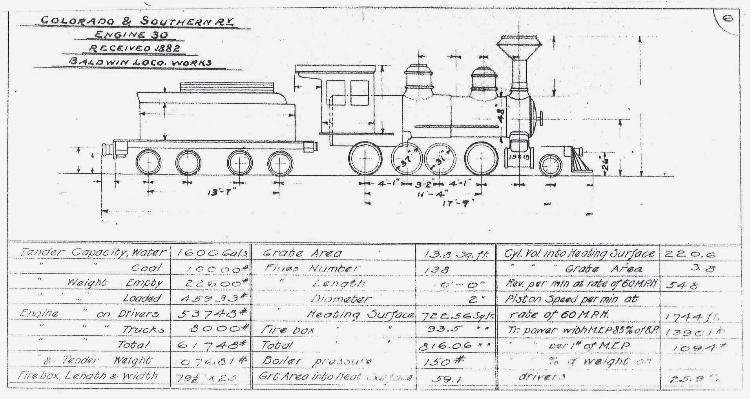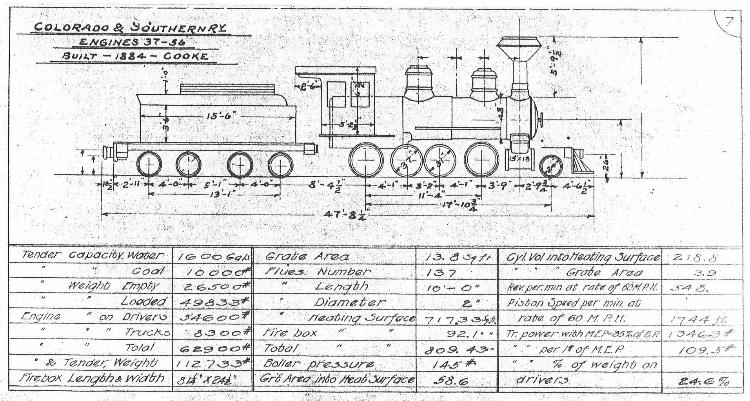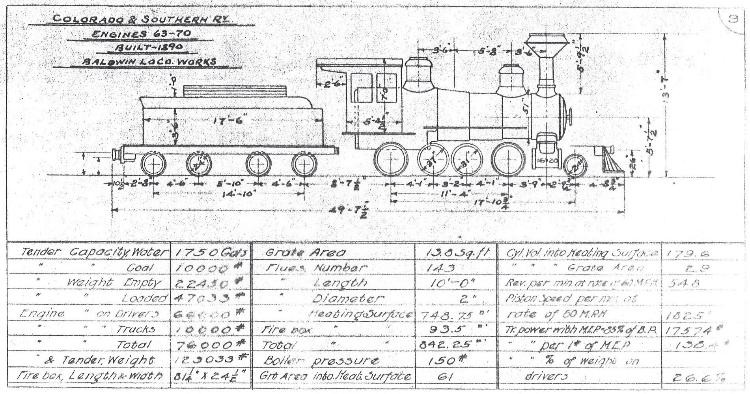Visual distinctions between B-4C and B-4D?
Visual distinctions between B-4C and B-4D?
|
The Rhode Island consolidations appear to have started off with beaded domes, which were later replaced with smooth ones.
 http://digital.denverlibrary.org/cdm/singleitem/collection/p15330coll22/id/42213/rec/1  http://digital.denverlibrary.org/cdm/singleitem/collection/p15330coll22/id/42217/rec/4 The Baldwin connies, for the most part, appear to have smooth domes from the start, except for 69 which had one of each.  http://digital.denverlibrary.org/cdm/singleitem/collection/p15330coll22/id/42242/rec/1  http://digital.denverlibrary.org/cdm/singleitem/collection/p15330coll22/id/42275/rec/3 There's also the question of the small smokebox door, which 60 has, but 59 does not.  http://digital.denverlibrary.org/cdm/fullbrowser/collection/p15330coll22/id/42512/rv/singleitem/rec/2  http://digital.denverlibrary.org/cdm/singleitem/collection/p15330coll22/id/42219/rec/1 So, what exactly are the canonical differences? Thanks, Jeff. |
Re: Visual distinctions between B-4C and B-4D?
|
#58's original dome were swapped with a standard gauge engine that the CB&Q was restoring. I don't remember what event it was for, or which engine, but the fluted domes were ideal for their purpose. I'm glad they did, as it gave #58 that unique look.
|
Re: Visual distinctions between B-4C and B-4D?
|
Interesting.
I thought #60 also got the "upgrade", but I now see it was only the steam dome, so it's sort of the mirror image of #69. (Almost makes you wonder if the steam domes were swapped between #60 and #69....) |
Re: Visual distinctions between B-4C and B-4D?
|
This post was updated on .
Both the miss matched domes on 60 and 69 were the result of replacement domes to repair wreck damage. It's not clear where the new domes came from, other narrow or standard gauge engines.
The Rhode Island B-4-Cs were originally built for the Utah and Northern, and came to the South Park (DL&G) when the U&N was standard gauged. The Baldwin B-4-Ds were built new for the South Park / DL&G a few years later. From: http://utahrails.net/utahrails/utah-and-northern-ry-1878-1889.php#locomotives 1885 UP System: Utah & Northern Ry 2-8-0 -- 6 locomotives Date 1889 OSL&UN Number, 1890 DL&G Number, 1899 C&S Number Notes U&N 260 Rhode Island 1592 Feb 1886 OSL&UN 260 DL&G 260 C&S 57 U&N 261 Rhode Island 1593 Feb 1886 OSL&UN 261 DL&G 261 C&S 58 U&N 262 Rhode Island 1594 Mar 1886 OSL&UN 262 DL&G 262 C&S 59 U&N 263 Rhode Island 1595 Mar 1886 OSL&UN 263 DL&G 263 C&S 60 U&N 264 Rhode Island 1596 Apr 1886 OSL&UN 264 DL&G 264 C&S 61 U&N 265 Rhode Island 1597 Apr 1886 OSL&UN 265 DL&G 265 C&S 62 Description: Drive Wheel Diameter: 37 inches Cylinders: 16x18 inches Maximum Tractive Effort: 16,620 pounds Weight on Drivers: 60,200 pounds Engine Weight: 70,118 pounds General Notes: U&N 260-265 were the last new narrow gauge engines acquired by the Utah & Northern, as a group of six large 2-8-0 "Consolidated" engines, built in early 1886 by the Rhode Island Locomotive Works, Providence, Rhode Island. The May 1886 journal entry for the purchase of these locomotives (Nos. 260-265) is, at first glance, rather odd, since it is for only one locomotive - for which the likely explanation is that with six new locomotives being added, five old ones (Nos. 101, 285, 286, 296 and 297) were struck off, leaving a net of one new locomotive to be entered in the accounts. If the paperwork behind the May 1886 journal entry were ever to come to light, it would show that six new locomotives added, at $6,850.00 each, less five old locomotives vacated, at $6,850.00 each, leaves one new locomotive, at $6,850.00, to be charged in May of 1886. These locomotives, by far the largest on the Utah & Northern narrow gauge, were acquired primarily for the Butte-Anaconda ore trains,. but also with the haul over Monida Pass in mind; however, with the widening of the line from Butte to Garrison in July of 1886 (and its transfer to the Montana Union), the primary use of these engines became the Monida Pass work. Then, with the widening of the line north of Pocatello in July of 1887, little use for these engines remained on the bit of line still narrow gauge, and most (if not all) of these engines soon found their way to the South Park line in Colorado, to which road the entire class, all six of them, were transferred officially in July 1890. U&N 260-265 were renumbered to OSL&UN 260-265 in August 1889; the entire class was sold in July 1890 to Denver, Leadville & Gunnison Ry. 260-265; in January 1899 reorganization of UP's colorado roads as the Colorado & Southern Ry., they became C&S Nos. 57-62. C&S No. 60 (formerly U&N 263) donated to Idaho Springs, Colo., for display in 1941 (and still there), the others having been scrapped, in the 1923-1938 period. The small smoke box door with the 4 dogs was an original Rhode Island feature, all the B-4-Cs lost theirs, replaced with different doors with the 6 dogs, except for number 60. Number 60 in 1904 near Pitkin before the domes became mismatched; note the original Rhode Island smoke box door, just like today if you visit the engine at Idaho Springs:  Sister engine number 57 in the same train; note replacement, more conventional C&S smoke box door:  Both photos from Grandt's Narrow Gauge Pictorial VIII. Jim
Jim Courtney
Poulsbo, WA |
Re: Visual distinctions between B-4C and B-4D?
|
This post was updated on .
In studying the photos of 60 and sister 57 in 1904, the sand domes do look different.
Number 60 was involved in a famous, well photographed wreck on Boreas in 1901. The sand dome in the photo above may be number 60s first replacement dome, perhaps one of the tall Baldwin domes (as on D&RGW 278) removed from one of the B-4-A class Baldwin 2-8-0. A later wreck, in the 19teens as I recall, may have been the cause of the later smooth steam dome and yet a 3rd different sand dome, pictured as early as the mid-1920s. To further delineate the differences between the two classes (very few actually), these folio sheets from the 1903 C&S Locomotive Folio book might be of help:    I haven't finished scanning all of the folio sheets yet, eventually they will all end up in the "Files Section". Jim
Jim Courtney
Poulsbo, WA |
Re: Visual distinctions between B-4C and B-4D?
|
Thanks for all the great info, Jim. There really wasn't a lot between them, was there?
Cheers, Jeff. |
Re: Visual distinctions between B-4C and B-4D?
|
In reply to this post by Jim Courtney
CONTENTS DELETED
The author has deleted this message.
|
Re: Visual distinctions between B-4C and B-4D?
|
This post was updated on .
Sure, will post it Sunday, working in the hospital for next 24 hours.
Actually, I think all three folios for the B-4-Cs, Ds and Es are the same drawing, with different information entered at the bottom describing the differences. Note that on the folio for the B-4-Cs, the draftsman forgot to ink in the dimensions on the drawing. Nor did he bother to represent the Rhode Island domes correctly.
Jim Courtney
Poulsbo, WA |
Re: Visual distinctions between B-4C and B-4D?
|
In reply to this post by Jeff Young
When were engines of both classes reboilered?From the folio sheets it looks like they used the same boiler.
|
Re: Visual distinctions between B-4C and B-4D?
|
From Derrell's past posts, I don't think you can draw any conclusions from the folio drawings themselves as to specific locomotive features or dimensions. As Derrell commented, it was the actual dimensions and data that was recorded on the sheets that was important. It is a shame that the drawing for the B-4-Cs are missing so much dimensional data.
Again, for the 3 classes of 2-8-0s past the Cooke engines, I think the same drawing (diagram) was traced and used as a vehicle to record individual class data, though all 3 classes were very similar in basic dimensions. Only cosmetic features like domes, air tanks, cab windows and headlights differed, often between engines within the same class, often over time for the same engine. It is things like engine weight, tractive effort, etc that defined the differences between the classes. Please don't mistake me for an expert on the nuances of C&S motive power diffences. Derrell is far more knowledgeable in this area. If the 1886 Rhode Islands or 1890 Baldwins were reboilered, I simply don't know.
Jim Courtney
Poulsbo, WA |
Re: Visual distinctions between B-4C and B-4D?
|
In reply to this post by Jim Courtney
CONTENTS DELETED
The author has deleted this message.
|
Re: Visual distinctions between B-4C and B-4D?
|
John, not only will I see your request for the B-4-E folio sheet, I will raise you sheets for the B-4-A (number 30) and the B-4-Bs (Cooke) 2-8-0s. Even though it wasn't in the original 1903 Folio book, I'll also throw in a sheet for the big DB&W B-4-Fs.
This will give me some impetus to get on with scanning the whole book. jim
Jim Courtney
Poulsbo, WA |
Re: Visual distinctions between B-4C and B-4D?
|
CONTENTS DELETED
The author has deleted this message.
|
Re: Visual distinctions between B-4C and B-4D?
|
Here you go, John,
All of the C&S consolidations per the 1903 Locomotive Folio Sheets, from lessor to greater. The B-4-etc classification system hadn't been created in 1903, so I've added those labels. Some sheets reproduce better than others, the sheet for the B-4-Fs is from a another source and is very hard to read, even the original.  B-4-A, Baldwin  B-4-B, Cooke  B-4-C, Rhode Island  B-4-D, Baldwin  B-4-D, Baldwin, Addendum to the book from about 1929  B-4-E, Baldwin  B-4-F, Brooks I have always thought that the B-4-Cs, Ds, and Es, by virtue of their two course boilers, always looked bigger than their D&RG counterparts. But comparing the physical qualities of C&S 2-8-0s to those of the D&RG, they were either similar or actually lighter. If you apply Evil Empire metrics in terms of engine weights and tractive effort to the C&S engines, they would have been classed by the D&RG as such: B-4-A, Baldwin = D&RG "Class 55, later C-13" B-4-B, Cooke = D&RG "Class 55, later C-14" B-4-C, Rhode Island = D&RG "Class 63, later C-16" B-4-D, Baldwin = D&RG "Class 66, later C-18" B-4-E, Baldwin = D&RG "Class 71, later C-20" B-4-E, Brooks = D&RG "Class 85, later C-21" The three D&RGW C-19s, leased in the late 1930s, were a little more powerful than C&S 63-70, a little lighter than C&S 71-73. The B-4-Es, 71-73 were significantly lighter than the DB&W engines 74-76, but almost as powerful as the larger engines in terms of tractive effort. Jim
Jim Courtney
Poulsbo, WA |
Re: Visual distinctions between B-4C and B-4D?
|
CONTENTS DELETED
The author has deleted this message.
|
Re: Visual distinctions between B-4C and B-4D?
|
Indeed, great stuff Jim!
|
Re: Visual distinctions between B-4C and B-4D?
|
In reply to this post by Tim Schreiner
C&S 58's domes went on CB&Q #35 which became the Q's demonstration engine. It is now displayed at the Patte House in St. Joseph if you want to go look at some original C&S domes. 8^)
Ken |
«
Return to C&Sng Discussion Forum
|
1 view|%1 views
| Free forum by Nabble | Edit this page |

